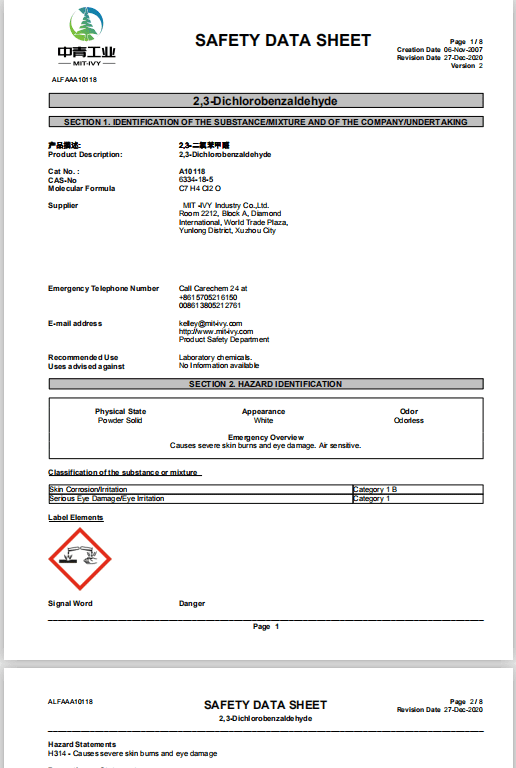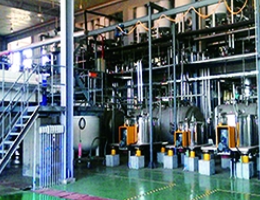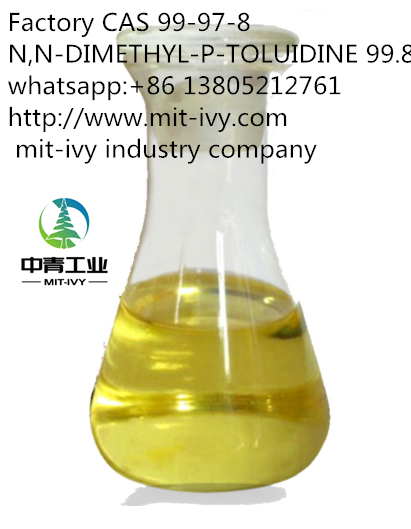Intermediates are a very important type of fine chemical products. In essence, they are a kind of “semi-finished products”, which are widely used in the synthesis of medicine, pesticides, coatings, dyes and spices.
In medicine, intermediates are used to produce APIs.
So what is the niche industry of pharmaceutical intermediates?
The so-called pharmaceutical intermediates are actually some chemical raw materials or chemical products used in the process of drug synthesis.
The chemical, which does not require a drug manufacturing license, can be produced in a conventional chemical plant and, when it reaches certain levels, can be used in the synthesis of drugs.
The picture
At present, the most promising varieties of pharmaceutical intermediates are mainly as follows:
Nucleoside intermediates.
This kind of intermediate synthesis of anti-AIDS drugs is mainly zidovudine, from the United States Glaxo.
Wellcome and Bristol-Myers Squibb make it.
Cardiovascular intermediates.
For example, synthetic sartans have become widely used in the treatment of hypertension due to their more complete antihypertensive effect, fewer side effects, long efficacy (stable control of blood pressure for 24 hours) and the ability to be used in combination with other sartans.
According to statistics, in 2015, the global demand for major sartan drug active substances (losartan potassium, olmesartan, valsartan, irbesartan, telmisartan, candesartan) reached 3,300 tons.
Total sales were $21.063 billion.
Fluorinated intermediates.
Fluorinated drugs synthesized from such intermediates have developed rapidly in recent years due to their excellent efficacy. In 1970, only 2% of fluorinated drugs were on the market; by 2013, 25% of fluorinated drugs were on the market.
Representative products such as fluoroquinolone anti-infective drugs, antidepressant fluoxetine and antifungal fluconazole account for a high proportion in clinical use, among which fluoroquinolone anti-infective drugs account for about 15% of the global market share of anti-infective drugs.
In addition, trifluoroethanol is an important intermediate for the synthesis of anesthetics, while trifluoromethylaniline is an important intermediate for the synthesis of antimalarial drugs, anti-inflammatory and analgesic drugs, anti-prostate drugs and anti-depressants, and the market prospect is very broad.
Heterocyclic intermediates.
With pyridine and piperazine as representatives, it is mainly used in the synthesis of anti-ulcer drugs, bulk gastric drugs, anti-inflammatory and anti-infective drugs, highly effective antihypertensive drugs and new anti-breast cancer drugs letrozole.
02
Pharmaceutical intermediates are an important link in pharmaceutical industry chain.
The picture
Upstream is the basic chemical raw materials, most of which are petrochemical products, such as acetylene, ethylene, propylene, butene and butadiene, toluene and xylene.
Pharmaceutical intermediates are subdivided into primary intermediates and advanced intermediates.
Among them, primary intermediate suppliers can only provide simple intermediate production and are at the front of the industrial chain with the greatest competitive pressure and price pressure. Therefore, the price fluctuation of basic chemical raw materials has a great impact on them.
On the other hand, advanced intermediate suppliers not only have strong bargaining power over primary suppliers, but more importantly, because they undertake the production of advanced intermediates with high technical content and maintain closer contact with multinational companies, they are less affected by the price fluctuation of raw materials.
The middle reaches belong to pharmaceutical fine chemical industry.
Manufacturers of pharmaceutical intermediates synthesize intermediates or crude APIs, and sell the products in the form of chemical products to pharmaceutical companies, which refine them and then sell them as drugs.
Pharmaceutical intermediates include generic products and customized products. According to the different outsourcing service stages, the customized business models of intermediates can be generally divided into CRO (contract research and development outsourcing) and CMO (contract production outsourcing).
In the past, CMO business outsourcing mode was mainly used in pharmaceutical intermediates.
Under the CMO model, pharmaceutical companies outsource production to partners.
Therefore, the business chain generally begins with specialized pharmaceutical raw materials.
Industry companies need to purchase basic chemical raw materials and classify and process them into specialized pharmaceutical raw materials, and then reprocess them into API starting materials, cGMP intermediates, APIs and preparations.
But, as the drug companies for cost control and efficiency requirements, simple production outsourcing services have been unable to meet the demand of enterprise, CDMO mode (production research and development outsourcing) arises at the historic moment, CDMO needs customization production enterprises to participate in the customer in the process of research and development, to provide process improvement or optimization, realize large-scale production quality, reduce production cost,
It has higher profit margins than the CMO model.
The downstream is mainly the API production industry, and the API is in the upstream and downstream industrial chain relationship with the preparation.
Therefore, the consumption demand of the downstream drug preparation will directly affect the demand of the API, and then affect the demand of the intermediate.
From the perspective of the whole industrial chain, pharmaceutical intermediates are still in the growth stage at present, and the average gross profit rate is generally 15-20%, while the average gross profit rate of API is 20-25%, and the average gross profit rate of downstream pharmaceutical preparations is as high as 40-50%. Obviously, the gross profit rate of the downstream part is significantly higher than that of the upstream part.
Therefore, pharmaceutical intermediate enterprises can further extend product chain, increase product profit and improve the stability of sales by producing API in the future.
03
The high development of pharmaceutical intermediates industry in China began in 2000.
At that time, pharmaceutical companies in developed countries paid more and more attention to product research and development and market development as their core competitiveness, and accelerated the transfer of intermediates and active drug synthesis to developing countries with lower costs.
Therefore, pharmaceutical intermediates industry in China has achieved excellent development by taking this opportunity.
After more than ten years of steady development, with the support of national overall regulation and policies, China has become an important intermediate production base in the global division of labor in the pharmaceutical industry.
From 2012 to 2018, the output of China’s pharmaceutical intermediates industry increased from about 8.1 million tons with a market size of about 168.8 billion yuan to about 10.12 million tons with a market size of 2010.7 billion yuan.
The picture
China’s pharmaceutical intermediates industry has achieved a strong market competitiveness, and even some intermediate production enterprises have been able to produce intermediates with complex molecular structure and high technical requirements. A large number of influential products have begun to dominate the international market.
However, in general, the intermediate industry in China is still in the development period of product structure optimization and upgrading, and the technological level is still relatively low.
Primary pharmaceutical intermediates are still the main products in the pharmaceutical intermediates industry, and there are few enterprises producing a large number of advanced pharmaceutical intermediates and supporting intermediate products of patented new drugs.
At present, the more competitive A-share listed companies in the intermediate industry are Yaben Chemical, Lianhua Technology, Boten, and Wanrun, which plans to invest 630 million yuan in the construction of pharmaceutical intermediates and API projects with A total capacity of 3,155 tons/year.
They continue to develop a range of products through research and development, in order to find new ways.
Yaben Chemical Co., Ltd. (300261) : Our main products include antitumor drug intermediates, antiepileptic drug intermediates and antiviral intermediates.
Among them, ABAH, an antiepileptic drug intermediate, was officially put into production in October 2014, with a capacity of 1,000 tons.
Enzyme fermentation technology was successfully introduced into cardiovascular intermediates to enhance the competitiveness of the products.
In 2017, the company acquired ACL, an active substance pharmaceutical company in Malta, accelerating its layout in the international medical market and driving the transformation and upgrading of the domestic base.
BTG (300363) : focused on innovative drug intermediates /API customized CMO business, the main products are pharmaceutical intermediates for anti-hepatitis C, anti-AIDS, hypolipidemia and analgesia, and it is the core supplier of Sofebuvir intermediates for Gilead’s anti-hepatitis C drug.
In 2016, the total revenue of anti-diabetes + anti-hepatitis C drug intermediates reached 660 million, accounting for 50% of the total revenue.
However, since 2017, due to the gradual cure of hepatitis C patients and the decreasing patient population, Gilead’s sales of hepatitis C drugs began to decline. Moreover, with the expiration of patents, more and more anti-hepatitis C drugs were launched, and the competition continued to intensify, resulting in the decline of intermediate orders and revenue.
At present, the company has transformed from CMO business to CDMO business to build a leading global service platform for pharmaceutical enterprises.
Alliance Technology (002250) :
Pharmaceutical intermediates products are mainly involved in antitumor drugs, autoimmune, antifungal drugs, cardiovascular drugs, diabetes drugs, antidepressants, antihypertensive drugs, anti-flu drugs, such as basic are all in the therapeutic areas of the world’s most popular and wide space of market, the rapid growth in recent years, income compound growth rate of about 50%.
Among them, the “annual output of 300 tons of Chunidine, 300 tons of Fluzolic Acid and 200 tons of Cyclopyrimidine Acid Project” has been put into production successively since 2014.
Post time: Apr-12-2021









